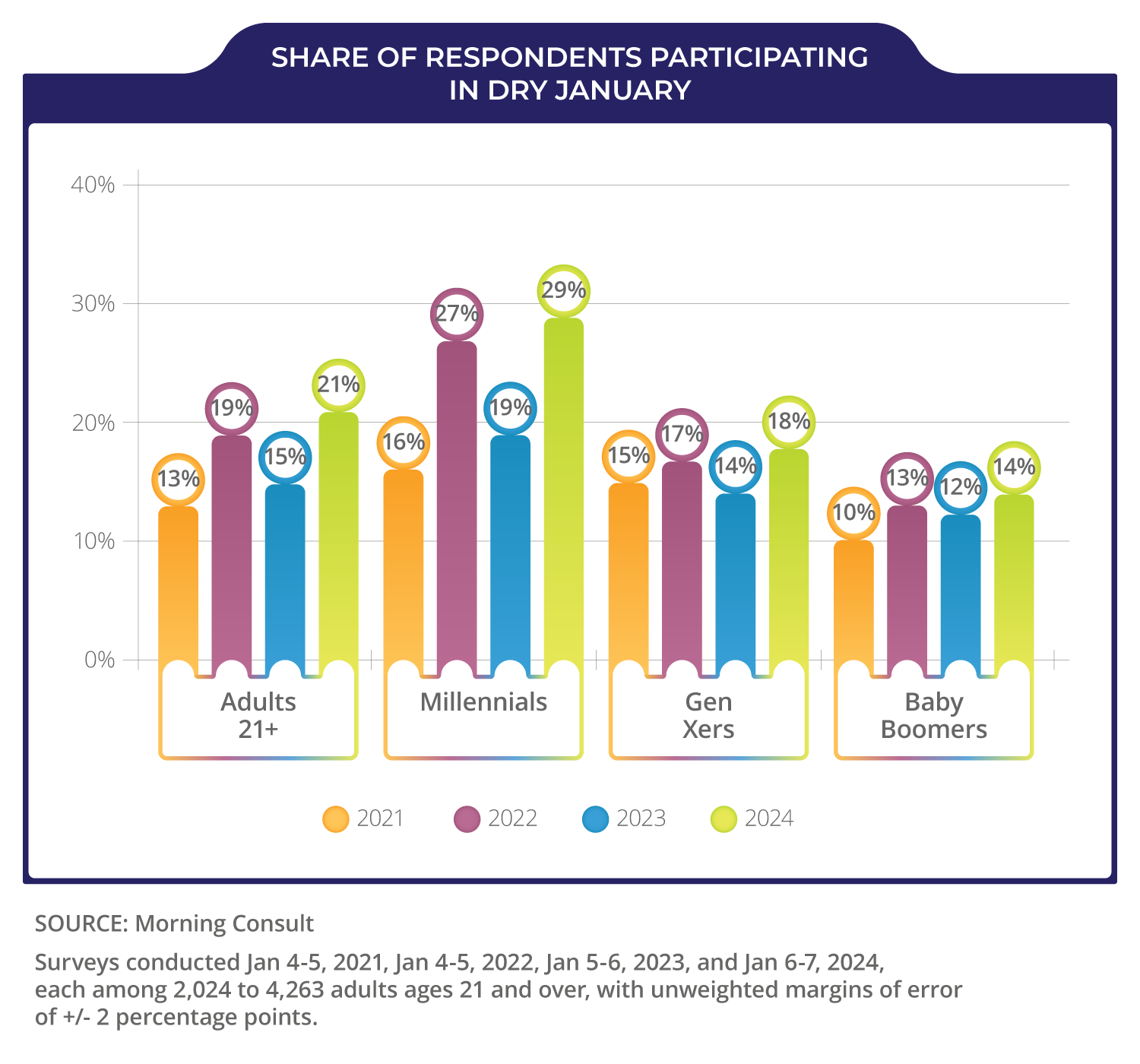
How to Stay Relevant in Dry January
It’s not about you; it’s about them.
It’s happening. We can’t stop it.
Dry January—a month-long challenge to reset drinking habits—has become a global trend. Initiated as a time for people to reflect on their relationship with alcohol, create healthier routines, and begin the year with mindfulness at the forefront, it can be a challenging time in an industry relying on consumption, with many consumers stepping back from wine and spirits entirely.
But here’s the thing—Dry January doesn’t have to be a buzzkill. In fact, it’s a golden opportunity to connect with your audience in new, fresh, and meaningful ways

While the idea of a booze-free month sounds noble, reality often paints a different picture. According to CivicScience, about 41% of adults in the U.S. planned to participate in Dry January in 2023. The reality is 16% managed to do so all month. For wineries, this isn’t bad news—it’s a window of opportunity! Instead of focusing on strict abstinence, you can shift the conversation to moderation, mindfulness, and balance. But, how do you stay relevant when everyone’s pretending to love sparkling water? Here are three actionable ways to keep your brand thriving all month long.
Focus on Your Brand, Not Your Product
More consumers are seeking transparency and connection with the products they consume, and wine is no exception. January is the perfect time to showcase how your brand values align with health, mindfulness, and wellness. (Notice we said “brand”. We do not recommend you try to position your wine as healthy, which is highly regulated and not advisable. But nothing says a winery cannot show their consumer as part of a balanced, healthy diet, social life or lifestyle.)
Start by emphasizing the aspects of your winemaking process that appeal to health-conscious individuals. If you use organic grapes, biodynamic farming methods, or practice sustainability. Let your customers know you’re not just producing great wine—you’re saving the planet one vineyard plot at a time. These details not only resonate with environmentally conscious drinkers but also reflect your commitment to mindful production.
You can build on this by showcasing your wine with healthy, fresh, and vibrant recipes or serving suggestions and showing the wines in situations with people enjoying friendship, family, and different activities. Avoid leaning into old troupes of serious, contemplative, or solitary consumption that seem to back up the WHO claim that all alcohol creates psycho-dependence and destructive behavior.
If your winery offers low-calorie or low-alcohol wines, Dry January presents a unique chance to spotlight these products. Position yourself as an excellent choice for those who want to enjoy a glass without overindulgence. Similarly, consider introducing educational content, such as workshops or social posts on mindful drinking. A class like “The Art of Savoring Each Sip” can elevate the conversation and encourage consumers to enjoy wine more thoughtfully. You could even offer incentives for responsible behavior, such as perks for designated drivers —because nothing says “we care,” like giving the DD a free charcuterie plate.
Remember, most of those attracted to Dry January are doing so because they seek ways to be present in their daily lives. By presenting wine as part of a balanced, modern lifestyle, you’re not just staying in the conversation for January—you’re building a year-round message that resonates with your audience. Meet your audience where they are. Show them that wine and wellness don’t have to be mutually exclusive—and that your brand is all about balance.
Hosting Events Beyond the Bottle
Dry January is the ideal time to think outside the bottle and transform your winery into a hub for creativity and community. Dry January might make it harder to pack your tasting room, but it doesn’t mean you can’t pack your calendar. Consider hosting events that bring people together without centering on wine. Transform vineyards into wellness havens with yoga classes and meditation sessions. If you have an estate chef, take advantage of their expertise by hosting cooking demonstrations or workshops that inspire healthier habits in the kitchen. These kinds of activities pair nicely with all those New Year’s resolutions everyone’s trying not to break.
Entertainment events like live music, trivia nights, or comedy shows are also excellent options. These activities provide an inviting atmosphere where guests can relax and connect without feeling pressured to drink. Even non-alcoholic offerings, such as mocktail tastings and food.
The key is to create a space where people feel welcome and engaged, regardless of their beverage choices. By offering these unique experiences, you keep your tasting room vibrant and show that your brand is about more than wine—it’s about connection, celebration, and community.
Sharing Stories That Inspire Connection
At its core, wine is about moments—shared meals, celebrations, and connections with loved ones. During Dry January, lean into the stories highlighting your brand’s lifestyle. Personal storytelling can be a powerful way to humanize your winery and build meaningful relationships with your audience. Share behind-the-scenes glimpses of your team, from vineyard workers to tasting room staff, and let their passion and expertise shine.
Don’t stop there—showcase your customers’ stories too. Highlight moments where your wine has been part of a milestone celebration, such as an anniversary dinner or a family gathering. It could inspire others to see your brand as part of their special occasions. These authentic, relatable stories invite customers to see themselves as part of your winery’s ongoing narrative.
When you focus on the human element of your brand, you remind your audience that wine isn’t just a product; it’s an experience. These stories show that your brand isn’t just about the wine—it’s about the memories, the moments, and the connections it helps create. Doing this during Dry January creates a sense of community and connection that resonates long after the month has ended.
Conclusion
At its heart, Dry January is not anti-alcohol – it is pro-connection. It is about people striving for healthier habits and a more balanced lifestyle. Contrary to what it may seem, wine can be part of this journey. By adapting to the wellness-focused priorities of your audience, you can ensure your brand remains relevant during this period and beyond.
Now is the time to innovate and engage. By highlighting the healthier aspects of wine country, hosting creative non-wine events, and sharing meaningful stories, your winery can turn Dry January into an opportunity to strengthen relationships with your customers. So don’t sweat Dry January. Embrace it, have fun with it, and show the world that you’re more than just a winery—you’re a source of inspiration, connection, and celebration.


